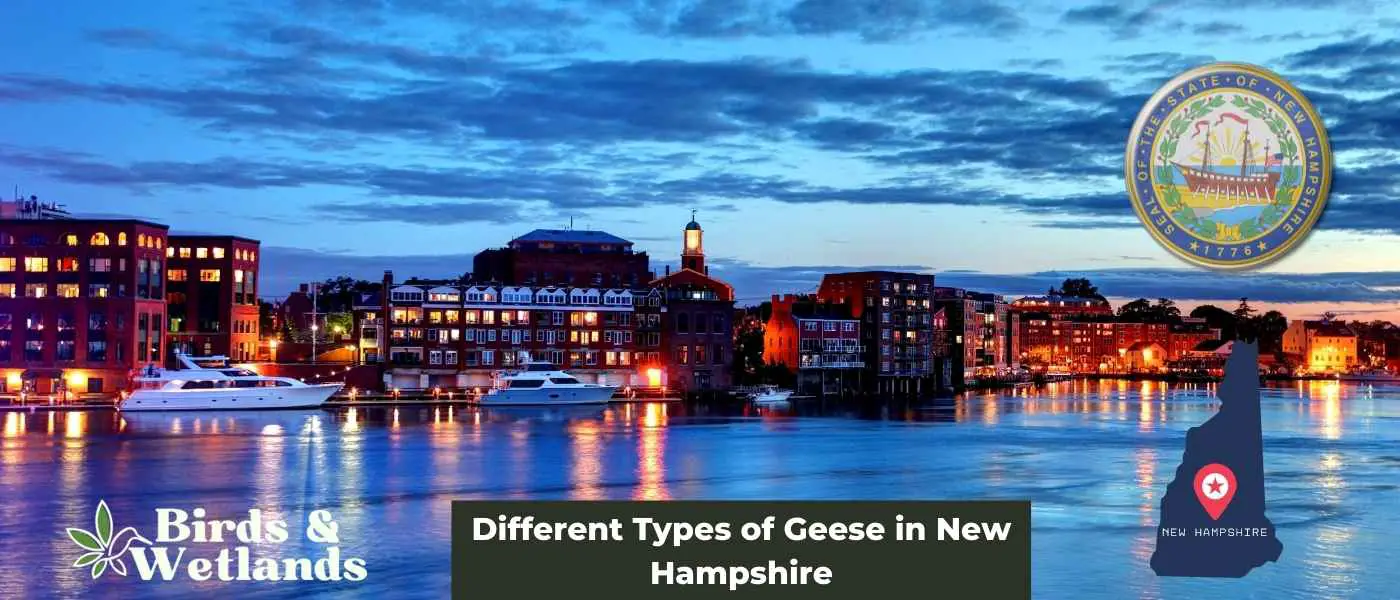There’s a reason why New Hampshire is called the Granite State. The rocky, hilly landscape is dotted with picturesque lakes and forests – and, of course, plenty of geese. Geese can be found in every corner of the state, from the mighty Atlantic Ocean to the soaring peaks of the White Mountains.
What Geese Are in New Hampshire?
There are eight goose species in New Hampshire.
- Canada Goose
- Snow Goose
- Ross’s Goose
- Cackling Goose
- Greater White-Fronted Goose
- Pink-footed Goose
- Barnacle Goose
- Brant
Canada Goose


Canada Goose Sound
Scientific Name: Branta canadensis
Length: 30 to 43 in
Wingspan: 50–73 in
Weight: 5.7–14.3 lb
The Canada Goose is a large, well-known species of waterfowl noted for its distinctive appearance, familiar “honk,” and migratory behavior.
Appearance: Both male and female Canada Geese have a similar appearance, featuring a black head and neck with distinctive white patches on the cheeks and chin. The body is primarily brown with a lighter, often white, underbelly.
Diet: Canada Geese primarily feed on plant matter, including grasses, aquatic vegetation, and grains. They can often be seen grazing in parks, lawns, and fields, as well as dabbling in water bodies.
Reproduction: Canada Geese typically nest on the ground near water bodies, often on islands or other isolated areas to avoid predators. The female lays a clutch of about 4 to 6 eggs, which she incubates alone for around a month.
Snow Goose

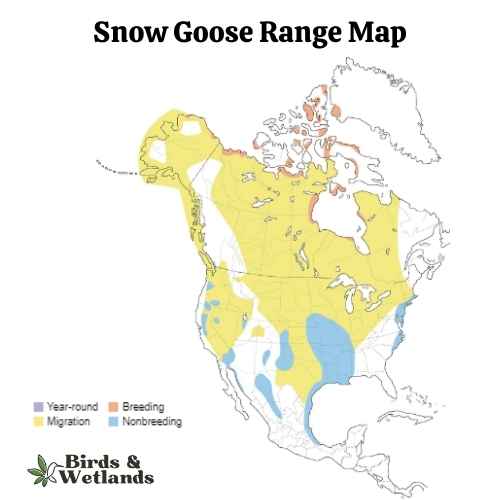
Snow Goose Sound
Scientific Name: Anser caerulescens
Length: 25 to 31 in
Wingspan: 53 to 65 in
Weight: 4.5 to 6.0
The Snow Goose is a large species of waterfowl known for its vibrant white plumage and significant migratory flights.
Appearance: True to their name, Snow Geese are predominantly white with black wingtips. They also have a pink bill, pink legs and feet. A color morph, known as the “Blue Goose,” displays a bluish-gray body with a white head, but is considered the same species.
Diet: Snow Geese primarily feed on plant matter, such as grasses, sedges, and small grains. They can often be seen in large flocks foraging in fields and marshes, and during migration and winter, they can cause considerable damage to agricultural fields due to their feeding habits.
Reproduction: Snow Geese typically nest on the tundra, near water bodies. The female builds the nest and lays a clutch of about 3 to 5 eggs, which she incubates alone for approximately three weeks. Once hatched, the goslings can feed themselves but stay with their parents for protection until they can fly.
Ross’s Goose
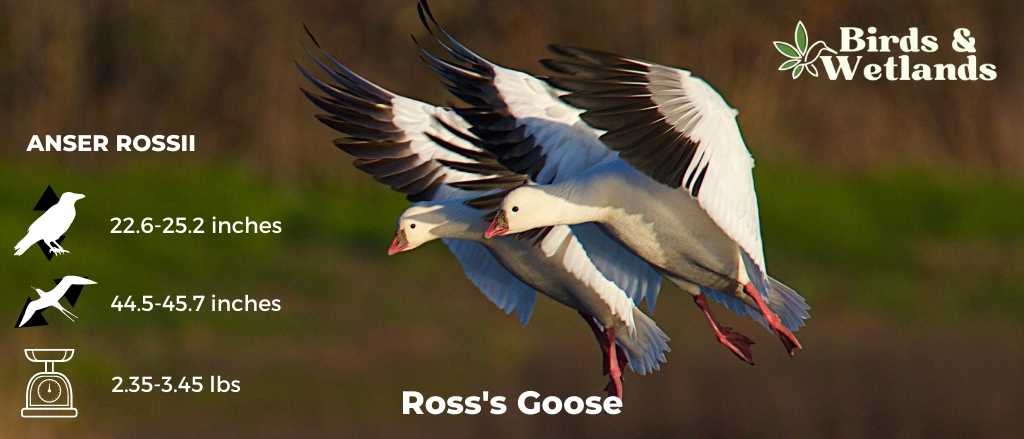
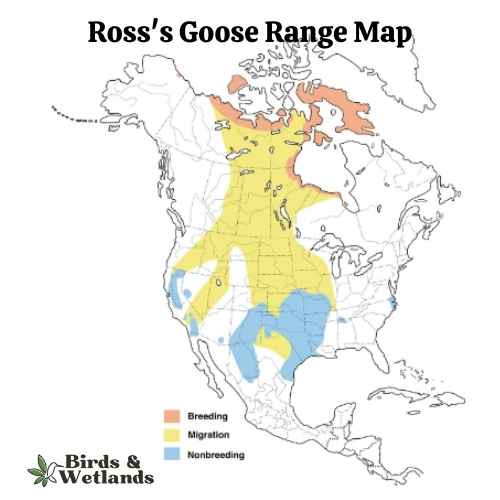
Listen
Scientific Name: Anser rossii
Length: 23.2-25.2
Wingspan: 44.5-45.7 in
Weight:42.3-55.3 oz
The Ross’s Goose is a small species of waterfowl often found in North America’s tundra and wetland habitats.
Appearance: Known for its compact size, the Ross’s Goose is mostly white with black wingtips. It features a short, stubby bill and a rounded head. One key identifying feature is the blueish gray base of its bill, which has a warty structure during the breeding season.
Diet: This goose feeds mainly on vegetation, including seeds, leaves, and roots of grasses and sedges. During winter and migration, they also consume grains and seeds from agricultural fields.
Reproduction: The Ross’s Goose nests on the ground, often in colonies. The female lays a clutch of 2 to 5 eggs which she incubates for around three weeks. The young geese, known as goslings, are precocial – they can walk, swim, and feed themselves shortly after hatching, although they stay with their parents until they learn to fly.
Cackling Goose
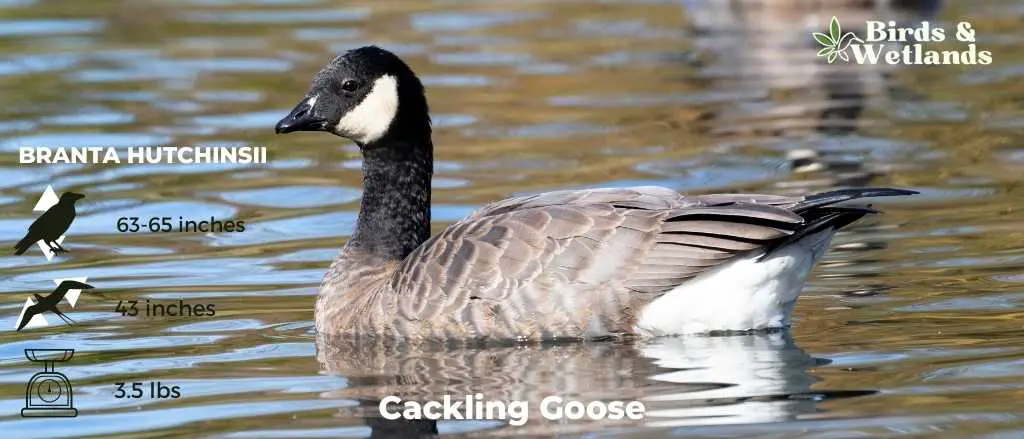
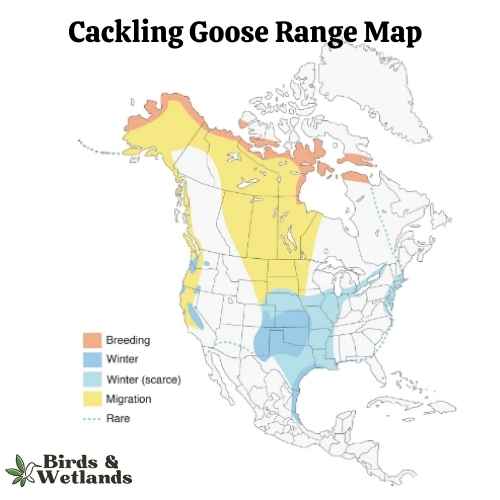
Listen
Scientific Name: Branta hutchinsii
Length: 24.8–25.6 in
Wingspan: 43-45.7 in
Weight:3.5 lbs
Cackling Geese are particularly known for their high-pitched, cackling calls, which is the source of their name. Despite their small size, these geese are renowned long-distance migrants, with some populations traveling thousands of miles between breeding and wintering grounds.
Appearance: With a similar color pattern to the larger Canada Goose, the Cackling Goose features a black head and neck, white chinstrap, light tan to cream chest, and brownish-grey body. One defining characteristic is its noticeably smaller size and stubbier neck compared to its larger counterparts.
Diet: Like many geese, the Cackling Goose’s diet mainly consists of plant matter. This includes grasses, seeds, and aquatic vegetation. They are often seen grazing on land or dabbling in shallow water.
Reproduction: Cackling Geese usually nest on the ground in elevated areas near water bodies, such as riverbanks or lakeshores. The female lays a clutch of 2 to 8 eggs and is responsible for incubation, while the male stands guard nearby. Incubation lasts for about a month.
Greater White-fronted Goose
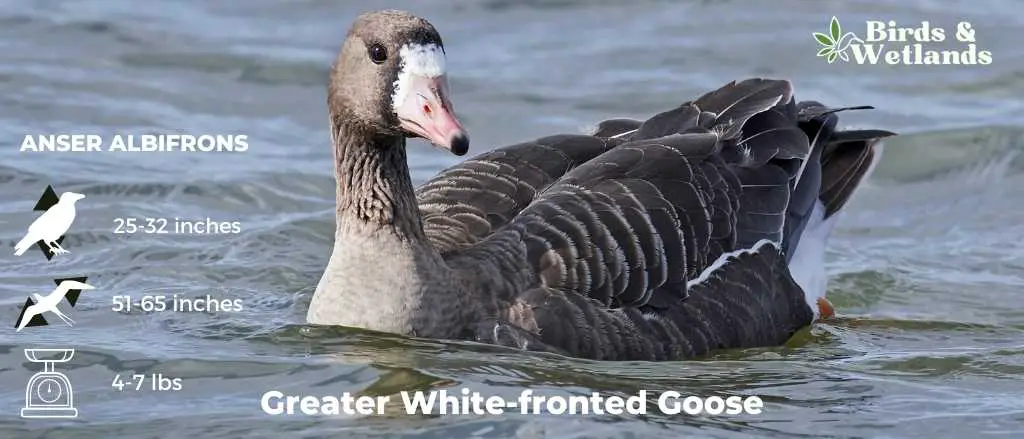

Listen
Scientific Name: Anser albifrons
Length: 25 to 31 in
Wingspan: 53 to 66 in
Weight: 3.3 to 6.6
The Greater White-fronted Goose is a medium to large waterfowl species, widely distributed across the Northern Hemisphere, particularly in North America.
Appearance: As the name suggests, these geese display a prominent white patch at the base of their bill. Their bodies are gray-brown, and their breasts are often marked with dark blotches. They possess a pinkish bill and orange legs and feet.
Diet: The Greater White-fronted Goose is a herbivore and feeds mainly on plant material. Its diet consists of grasses, sedges, grains, and berries. When wintering, these geese can often be found in agricultural fields, feasting on leftover grains and crops.
Reproduction: This species nests on the ground, often in areas with good visibility such as slopes or ridges. The female lays a clutch of 4 to 5 eggs, which she incubates for nearly a month. Once hatched, the young ones are taken care of by both parents until they are able to fly.
Pink-footed Goose (Anser brachyrhynchus)
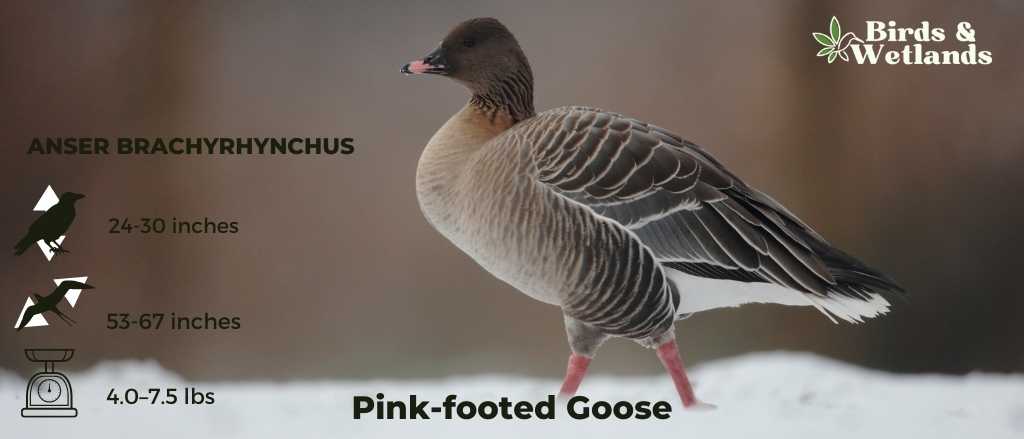
- Scientific Name: Anser brachyrhynchus
- Height: 60–75 cm (24–30 in)
- Wingspan: 135–170 cm (53–67 in)
- Weight: 1.8–3.4 kg (4.0–7.5 lb)
This is a rare visitor to North Eastern US, but becoming increasingly more common as it migrates with other geese species. It is a small goose which breeds in the Artic.
Pink-footed Goose Description
The Pink-footed Goose is a medium-sized goose with a pinkish bill and legs, as well as a white belly. It has a white head and neck with a black stripe running down its back and a black tail. The body is white except for a black breast, belly, and vent. The bill is yellow and red, with yellow on top and red on the bottom. The legs are pink.
Listen to Pink-footed Goose
Pink-footed Goose Habitat & Range
It’s a migratory goose that breeds in Iceland, Greenland, and Scandinavia. It winters on the coasts of North America and Europe. They are also known for gathering in large flocks to feed or roost together during migration.
In winter, they migrate south to warmer climates in Europe or Africa. The population is large enough that they can survive in areas where there is no natural water source for them to nest in—they simply dig holes in dry grassland instead.
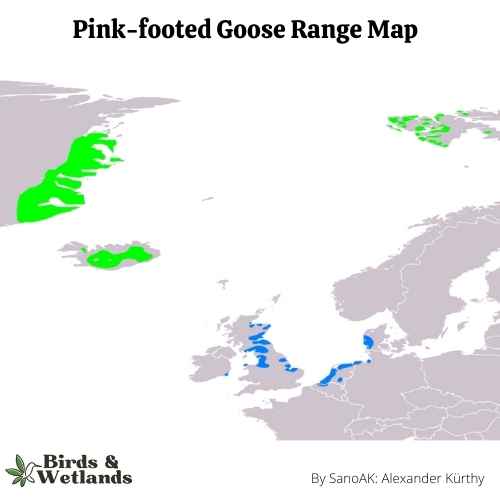
Pink-footed Goose Diet
Pink-footed geese feed on aquatic plants, including algae and tubers such as sedges and grasses; they also eat small fish and invertebrates such as snails or worms when they can find them.
Pink-footed Goose Nesting
They breed on the Arctic tundra near ponds or lakes that have open water in summer. Their nests are made formed in rocky crags. They lay 3-6 eggs per clutch and both parents incubate them for about 25 days.
Barnacle Goose (Branta leucopsis)

Rare in North America and when spotted its usually within a flock of Canada Geese.
- Scientific Name: Branta leucopsis
- Height: 55–70 cm (22–28 in)
- Wingspan: 130–145 cm (51–57 in)
- Weight: 1.21–2.23 kg (2.7–4.9 lb)
Barnacle Goose Description
The barnacle goose is a small goose with a white body and black wings, a black neck, with a white face and black bill. Its crown, eye line and legs are black.
Listen to Barnacle Goose
Barnacle Goose Habitat & Range
Barnacle geese are migratory geese that are native to the Arctic and northern Europe. They spend winters in southern Europe, Africa, India, and Australia. They breed in Iceland, Greenland, Northern Scandinavia, and Canada.

Barnacle Goose Diet
Barnacle Geese feed primarily on grasses, leaves, and other aquatic plants, grains, and algae during their breeding season but also consume insects during migration periods when food may be scarce.
Barnacle Goose Nesting
The Barnacle Goose lays 4-6 eggs in a nest lined with down but on the rock edge. The young Barnacle Goslings have to undergo significant challenges making their way from cliff edges to the water below a few hours after hatching.
Brant

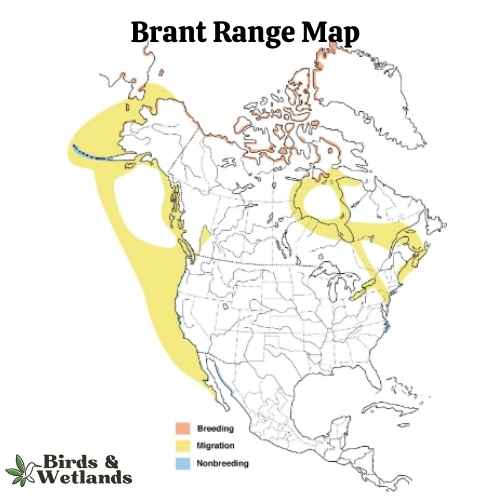
Listen
Scientific Name: Branta bernicla
Length: 22–26 in
Wingspan: 42–48 in
Weight: 1.9–4.9 lb
The Brant is a compact species of goose that is known for its striking appearance and interesting migratory patterns.
Appearance: The Brant is recognized for its dark, sooty color with a white crescent on the neck. The body is mostly black to dark gray, contrasting with the lighter underparts. Its small size, as compared to other geese, and short, stubby bill are other distinct features.
Diet: The Brant’s diet primarily consists of aquatic plants, especially eelgrass and sea lettuce. During the breeding season, they may also feed on grasses, sedges, and insects.
Reproduction: Brants typically breed in the high Arctic tundra. The female lays a clutch of 3 to 5 eggs in a ground nest, which she incubates for about a month.
Notably, Brants make an impressive long-distance migration every year. They spend their winters along both the east and west coasts of the United States and travel to the Arctic regions of Canada, Alaska, and even Russia to breed.
Does New Hampshire Have a Resident Flock of Geese?
Canadian geese can be found in every province and territory in Canada, as well as in many states in the United States. New Hampshire is no exception. While Canadian geese are not native to New Hampshire, they have been present in the state for many years. They have adapted really well and can find food easily.
In addition to being a popular sightseeing destination, Canadian geese are also known for causing damage to crops and golf courses. As a result, they are often considered to be a nuisance by homeowners and businesses. However, their presence in New Hampshire is protected by the Migratory Bird Treaty Act of 1918. This federal law makes it illegal to hunt, capture, or kill Canadian geese without a permit.
Hunting Geese in New Hampshire
In New Hampshire, goose hunting is only allowed during certain times of the year by the New Hampshire Fish and Game Department. The season generally runs from September to January. During the regular season, hunters are limited to two and six possession of Canada geese. The same daily bag and possession limits apply to Brants. As for Snow Geese, the limits are 25 bag limit and no possession limit.
In addition, hunters must have a valid hunting license and stamps and must adhere to all other state and federal regulations. For those looking to Goose hunt in New Hampshire, it is important to be aware of the rules and regulations in order to stay legal and safe.
Can You Shoot a Goose in New Hampshire?
In New Hampshire, it is illegal to hunt geese with certain methods. These include using a trap, snare, net, crossbow, rifle, pistol, swivel gun, shotgun larger than 10-gauge, punt gun, battery gun, machine gun, fishhook, poison, drug, explosive, or stupefying substance. Additionally, it is against the law to use a shotgun that is capable of holding more than three shells unless it is plugged with a one-piece filler. While these methods may be effective in killing geese, they are not allowed in New Hampshire and violators may face stiff penalties.
Where Can I Hunt Geese in New Hampshire?
New Hampshire is home to four different waterfowl hunting zones – Coastal, Northern, Connecticut River and Inland. Each zone has its own unique set of rules and regulations, so it’s important to be familiar with the laws before heading out on a hunt.
Conclusion on Geese in New Hampshire
If you’re looking to see some of the amazing wildlife that New Hampshire has to offer, be sure to keep an eye out for these eight species of geese. Whether you’re on a nature hike or just driving around town, you never know when you might spot one of these beautiful birds.

